Urban Planning Report: Informal Sector in Sango-Ota Central Area
VerifiedAdded on 2021/11/23
|15
|6616
|109
Report
AI Summary
This report examines the locational and environmental consequences of informal sector activities in Sango-Ota, Nigeria. The study begins with an introduction highlighting the growth of urban areas and the influx of people seeking socioeconomic betterment, which leads to environmental problems like urban sprawl and ineffective waste disposal. The research focuses on the informal sector, including street trading, auto repair, and tailoring services, and its impact on the environment. The research aims to assess the current situation, evaluate informality, and examine the historical background of the study area. The methodology involves primary data collection through questionnaires, observations, and interviews, along with secondary data review. The report investigates the nature of informal sector activities, identifies physical and socio-economic problems, and proposes strategies for addressing the environmental effects. The literature review explores the growth of informal activities, distinguishing between survivalist and micro-enterprises and the formal and informal sectors. The research emphasizes the need for urban planners and policymakers to understand the issues to mitigate the problems caused by informal sector activities.
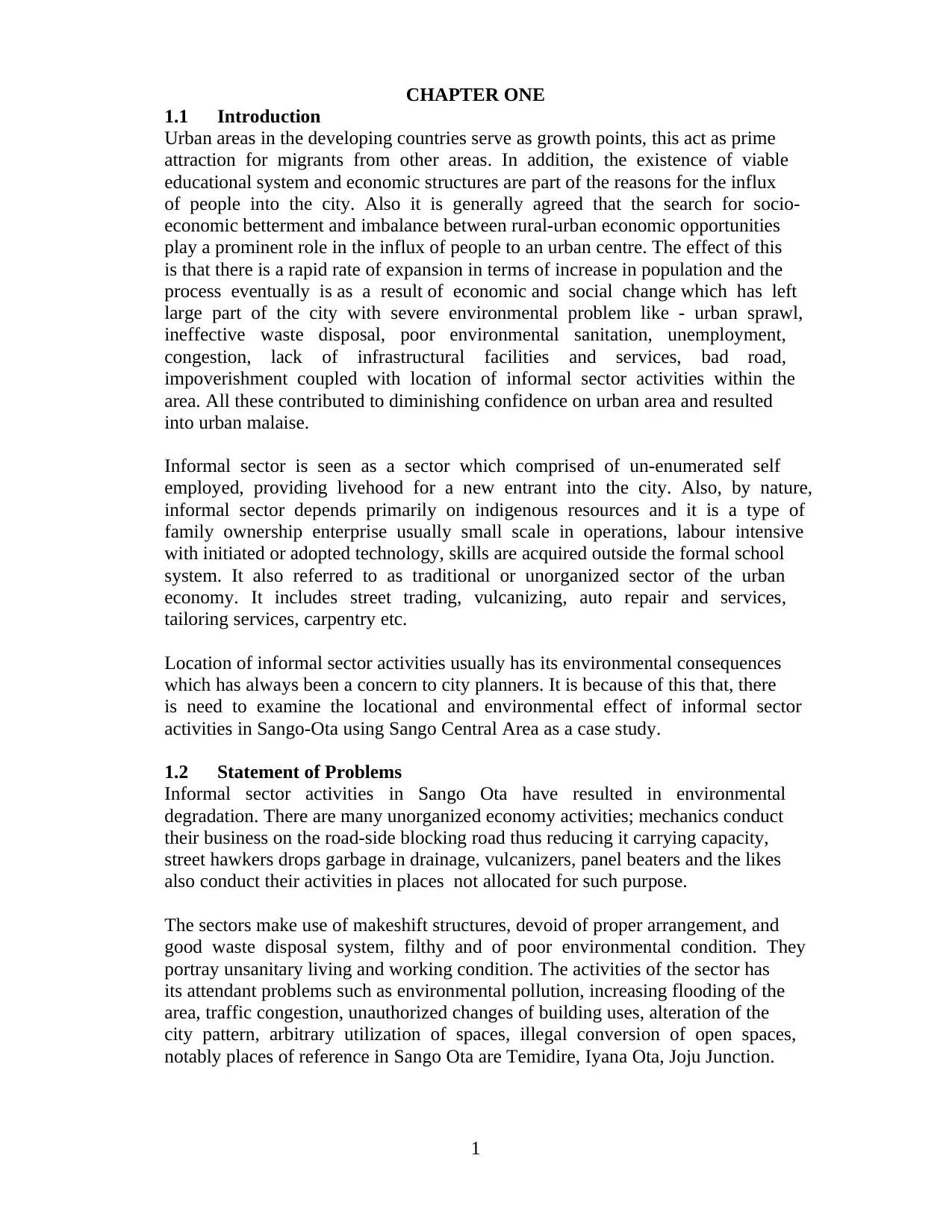
1
CHAPTER ONE
1.1 Introduction
Urban areas in the developing countries serve as growth points, this act as prime
attraction for migrants from other areas. In addition, the existence of viable
educational system and economic structures are part of the reasons for the influx
of people into the city. Also it is generally agreed that the search for socio-
economic betterment and imbalance between rural-urban economic opportunities
play a prominent role in the influx of people to an urban centre. The effect of this
is that there is a rapid rate of expansion in terms of increase in population and the
process eventually is as a result of economic and social change which has left
large part of the city with severe environmental problem like - urban sprawl,
ineffective waste disposal, poor environmental sanitation, unemployment,
congestion, lack of infrastructural facilities and services, bad road,
impoverishment coupled with location of informal sector activities within the
area. All these contributed to diminishing confidence on urban area and resulted
into urban malaise.
Informal sector is seen as a sector which comprised of un-enumerated self
employed, providing livehood for a new entrant into the city. Also, by nature,
informal sector depends primarily on indigenous resources and it is a type of
family ownership enterprise usually small scale in operations, labour intensive
with initiated or adopted technology, skills are acquired outside the formal school
system. It also referred to as traditional or unorganized sector of the urban
economy. It includes street trading, vulcanizing, auto repair and services,
tailoring services, carpentry etc.
Location of informal sector activities usually has its environmental consequences
which has always been a concern to city planners. It is because of this that, there
is need to examine the locational and environmental effect of informal sector
activities in Sango-Ota using Sango Central Area as a case study.
1.2 Statement of Problems
Informal sector activities in Sango Ota have resulted in environmental
degradation. There are many unorganized economy activities; mechanics conduct
their business on the road-side blocking road thus reducing it carrying capacity,
street hawkers drops garbage in drainage, vulcanizers, panel beaters and the likes
also conduct their activities in places not allocated for such purpose.
The sectors make use of makeshift structures, devoid of proper arrangement, and
good waste disposal system, filthy and of poor environmental condition. They
portray unsanitary living and working condition. The activities of the sector has
its attendant problems such as environmental pollution, increasing flooding of the
area, traffic congestion, unauthorized changes of building uses, alteration of the
city pattern, arbitrary utilization of spaces, illegal conversion of open spaces,
notably places of reference in Sango Ota are Temidire, Iyana Ota, Joju Junction.
CHAPTER ONE
1.1 Introduction
Urban areas in the developing countries serve as growth points, this act as prime
attraction for migrants from other areas. In addition, the existence of viable
educational system and economic structures are part of the reasons for the influx
of people into the city. Also it is generally agreed that the search for socio-
economic betterment and imbalance between rural-urban economic opportunities
play a prominent role in the influx of people to an urban centre. The effect of this
is that there is a rapid rate of expansion in terms of increase in population and the
process eventually is as a result of economic and social change which has left
large part of the city with severe environmental problem like - urban sprawl,
ineffective waste disposal, poor environmental sanitation, unemployment,
congestion, lack of infrastructural facilities and services, bad road,
impoverishment coupled with location of informal sector activities within the
area. All these contributed to diminishing confidence on urban area and resulted
into urban malaise.
Informal sector is seen as a sector which comprised of un-enumerated self
employed, providing livehood for a new entrant into the city. Also, by nature,
informal sector depends primarily on indigenous resources and it is a type of
family ownership enterprise usually small scale in operations, labour intensive
with initiated or adopted technology, skills are acquired outside the formal school
system. It also referred to as traditional or unorganized sector of the urban
economy. It includes street trading, vulcanizing, auto repair and services,
tailoring services, carpentry etc.
Location of informal sector activities usually has its environmental consequences
which has always been a concern to city planners. It is because of this that, there
is need to examine the locational and environmental effect of informal sector
activities in Sango-Ota using Sango Central Area as a case study.
1.2 Statement of Problems
Informal sector activities in Sango Ota have resulted in environmental
degradation. There are many unorganized economy activities; mechanics conduct
their business on the road-side blocking road thus reducing it carrying capacity,
street hawkers drops garbage in drainage, vulcanizers, panel beaters and the likes
also conduct their activities in places not allocated for such purpose.
The sectors make use of makeshift structures, devoid of proper arrangement, and
good waste disposal system, filthy and of poor environmental condition. They
portray unsanitary living and working condition. The activities of the sector has
its attendant problems such as environmental pollution, increasing flooding of the
area, traffic congestion, unauthorized changes of building uses, alteration of the
city pattern, arbitrary utilization of spaces, illegal conversion of open spaces,
notably places of reference in Sango Ota are Temidire, Iyana Ota, Joju Junction.
Paraphrase This Document
Need a fresh take? Get an instant paraphrase of this document with our AI Paraphraser
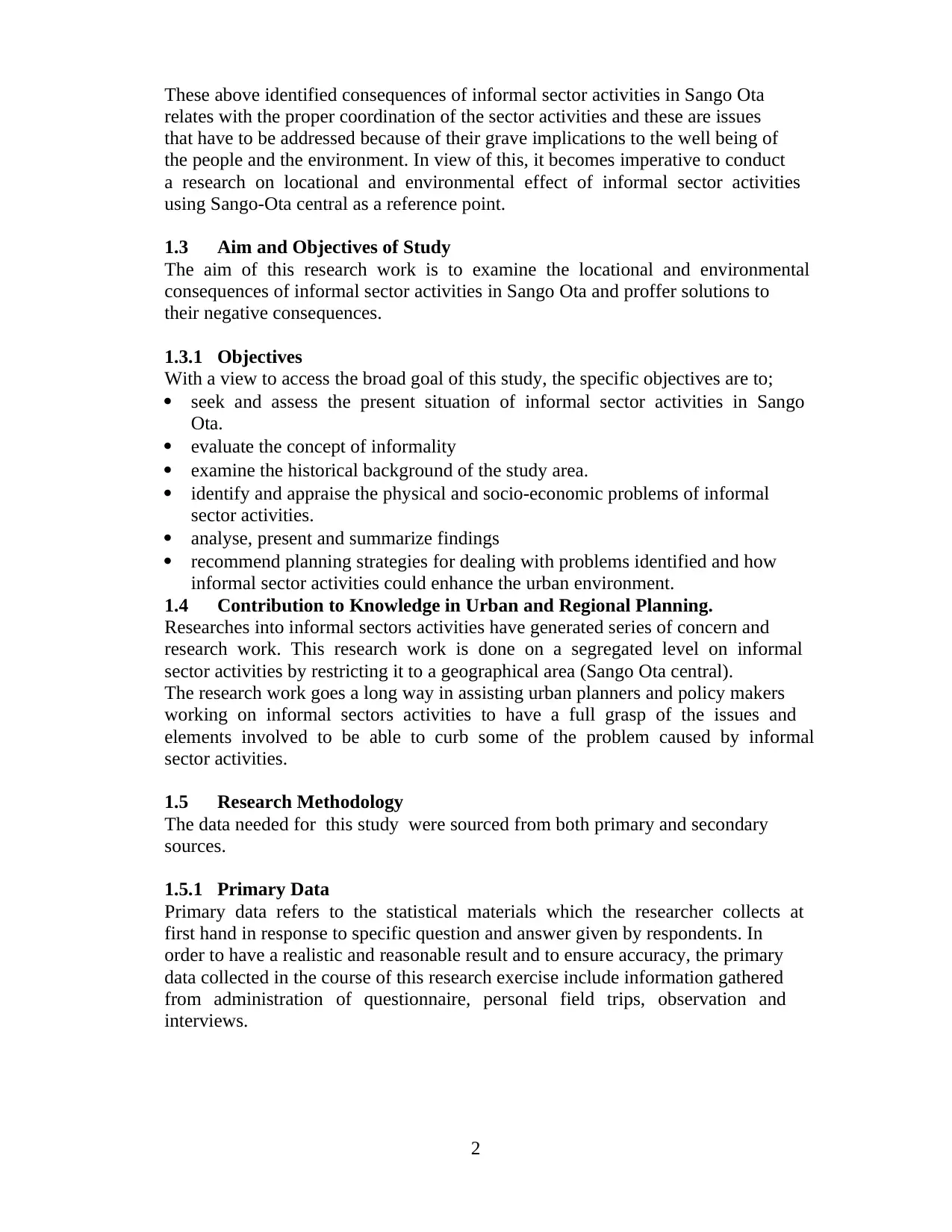
2
These above identified consequences of informal sector activities in Sango Ota
relates with the proper coordination of the sector activities and these are issues
that have to be addressed because of their grave implications to the well being of
the people and the environment. In view of this, it becomes imperative to conduct
a research on locational and environmental effect of informal sector activities
using Sango-Ota central as a reference point.
1.3 Aim and Objectives of Study
The aim of this research work is to examine the locational and environmental
consequences of informal sector activities in Sango Ota and proffer solutions to
their negative consequences.
1.3.1 Objectives
With a view to access the broad goal of this study, the specific objectives are to;
seek and assess the present situation of informal sector activities in Sango
Ota.
evaluate the concept of informality
examine the historical background of the study area.
identify and appraise the physical and socio-economic problems of informal
sector activities.
analyse, present and summarize findings
recommend planning strategies for dealing with problems identified and how
informal sector activities could enhance the urban environment.
1.4 Contribution to Knowledge in Urban and Regional Planning.
Researches into informal sectors activities have generated series of concern and
research work. This research work is done on a segregated level on informal
sector activities by restricting it to a geographical area (Sango Ota central).
The research work goes a long way in assisting urban planners and policy makers
working on informal sectors activities to have a full grasp of the issues and
elements involved to be able to curb some of the problem caused by informal
sector activities.
1.5 Research Methodology
The data needed for this study were sourced from both primary and secondary
sources.
1.5.1 Primary Data
Primary data refers to the statistical materials which the researcher collects at
first hand in response to specific question and answer given by respondents. In
order to have a realistic and reasonable result and to ensure accuracy, the primary
data collected in the course of this research exercise include information gathered
from administration of questionnaire, personal field trips, observation and
interviews.
These above identified consequences of informal sector activities in Sango Ota
relates with the proper coordination of the sector activities and these are issues
that have to be addressed because of their grave implications to the well being of
the people and the environment. In view of this, it becomes imperative to conduct
a research on locational and environmental effect of informal sector activities
using Sango-Ota central as a reference point.
1.3 Aim and Objectives of Study
The aim of this research work is to examine the locational and environmental
consequences of informal sector activities in Sango Ota and proffer solutions to
their negative consequences.
1.3.1 Objectives
With a view to access the broad goal of this study, the specific objectives are to;
seek and assess the present situation of informal sector activities in Sango
Ota.
evaluate the concept of informality
examine the historical background of the study area.
identify and appraise the physical and socio-economic problems of informal
sector activities.
analyse, present and summarize findings
recommend planning strategies for dealing with problems identified and how
informal sector activities could enhance the urban environment.
1.4 Contribution to Knowledge in Urban and Regional Planning.
Researches into informal sectors activities have generated series of concern and
research work. This research work is done on a segregated level on informal
sector activities by restricting it to a geographical area (Sango Ota central).
The research work goes a long way in assisting urban planners and policy makers
working on informal sectors activities to have a full grasp of the issues and
elements involved to be able to curb some of the problem caused by informal
sector activities.
1.5 Research Methodology
The data needed for this study were sourced from both primary and secondary
sources.
1.5.1 Primary Data
Primary data refers to the statistical materials which the researcher collects at
first hand in response to specific question and answer given by respondents. In
order to have a realistic and reasonable result and to ensure accuracy, the primary
data collected in the course of this research exercise include information gathered
from administration of questionnaire, personal field trips, observation and
interviews.
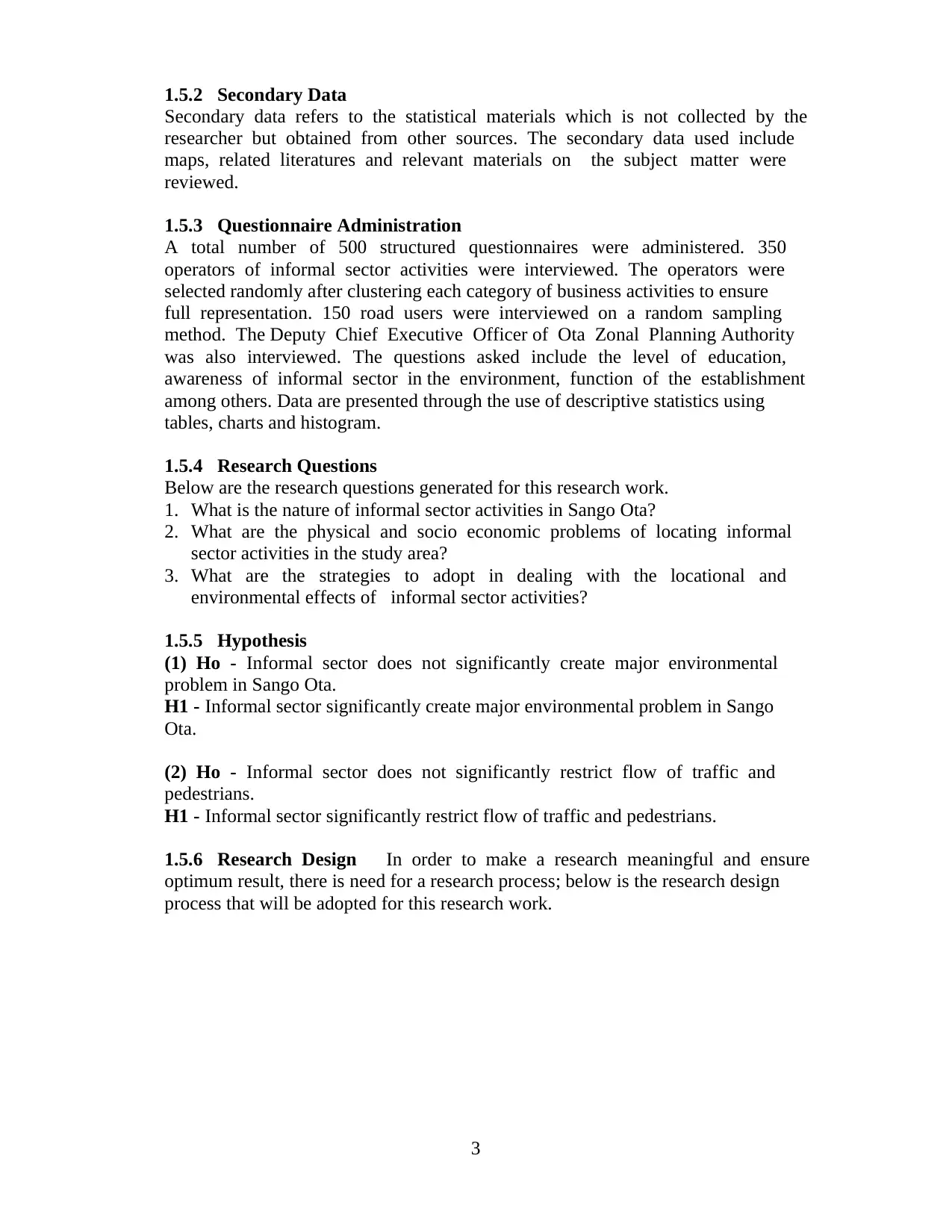
3
1.5.2 Secondary Data
Secondary data refers to the statistical materials which is not collected by the
researcher but obtained from other sources. The secondary data used include
maps, related literatures and relevant materials on the subject matter were
reviewed.
1.5.3 Questionnaire Administration
A total number of 500 structured questionnaires were administered. 350
operators of informal sector activities were interviewed. The operators were
selected randomly after clustering each category of business activities to ensure
full representation. 150 road users were interviewed on a random sampling
method. The Deputy Chief Executive Officer of Ota Zonal Planning Authority
was also interviewed. The questions asked include the level of education,
awareness of informal sector in the environment, function of the establishment
among others. Data are presented through the use of descriptive statistics using
tables, charts and histogram.
1.5.4 Research Questions
Below are the research questions generated for this research work.
1. What is the nature of informal sector activities in Sango Ota?
2. What are the physical and socio economic problems of locating informal
sector activities in the study area?
3. What are the strategies to adopt in dealing with the locational and
environmental effects of informal sector activities?
1.5.5 Hypothesis
(1) Ho - Informal sector does not significantly create major environmental
problem in Sango Ota.
H1 - Informal sector significantly create major environmental problem in Sango
Ota.
(2) Ho - Informal sector does not significantly restrict flow of traffic and
pedestrians.
H1 - Informal sector significantly restrict flow of traffic and pedestrians.
1.5.6 Research Design In order to make a research meaningful and ensure
optimum result, there is need for a research process; below is the research design
process that will be adopted for this research work.
1.5.2 Secondary Data
Secondary data refers to the statistical materials which is not collected by the
researcher but obtained from other sources. The secondary data used include
maps, related literatures and relevant materials on the subject matter were
reviewed.
1.5.3 Questionnaire Administration
A total number of 500 structured questionnaires were administered. 350
operators of informal sector activities were interviewed. The operators were
selected randomly after clustering each category of business activities to ensure
full representation. 150 road users were interviewed on a random sampling
method. The Deputy Chief Executive Officer of Ota Zonal Planning Authority
was also interviewed. The questions asked include the level of education,
awareness of informal sector in the environment, function of the establishment
among others. Data are presented through the use of descriptive statistics using
tables, charts and histogram.
1.5.4 Research Questions
Below are the research questions generated for this research work.
1. What is the nature of informal sector activities in Sango Ota?
2. What are the physical and socio economic problems of locating informal
sector activities in the study area?
3. What are the strategies to adopt in dealing with the locational and
environmental effects of informal sector activities?
1.5.5 Hypothesis
(1) Ho - Informal sector does not significantly create major environmental
problem in Sango Ota.
H1 - Informal sector significantly create major environmental problem in Sango
Ota.
(2) Ho - Informal sector does not significantly restrict flow of traffic and
pedestrians.
H1 - Informal sector significantly restrict flow of traffic and pedestrians.
1.5.6 Research Design In order to make a research meaningful and ensure
optimum result, there is need for a research process; below is the research design
process that will be adopted for this research work.
⊘ This is a preview!⊘
Do you want full access?
Subscribe today to unlock all pages.

Trusted by 1+ million students worldwide
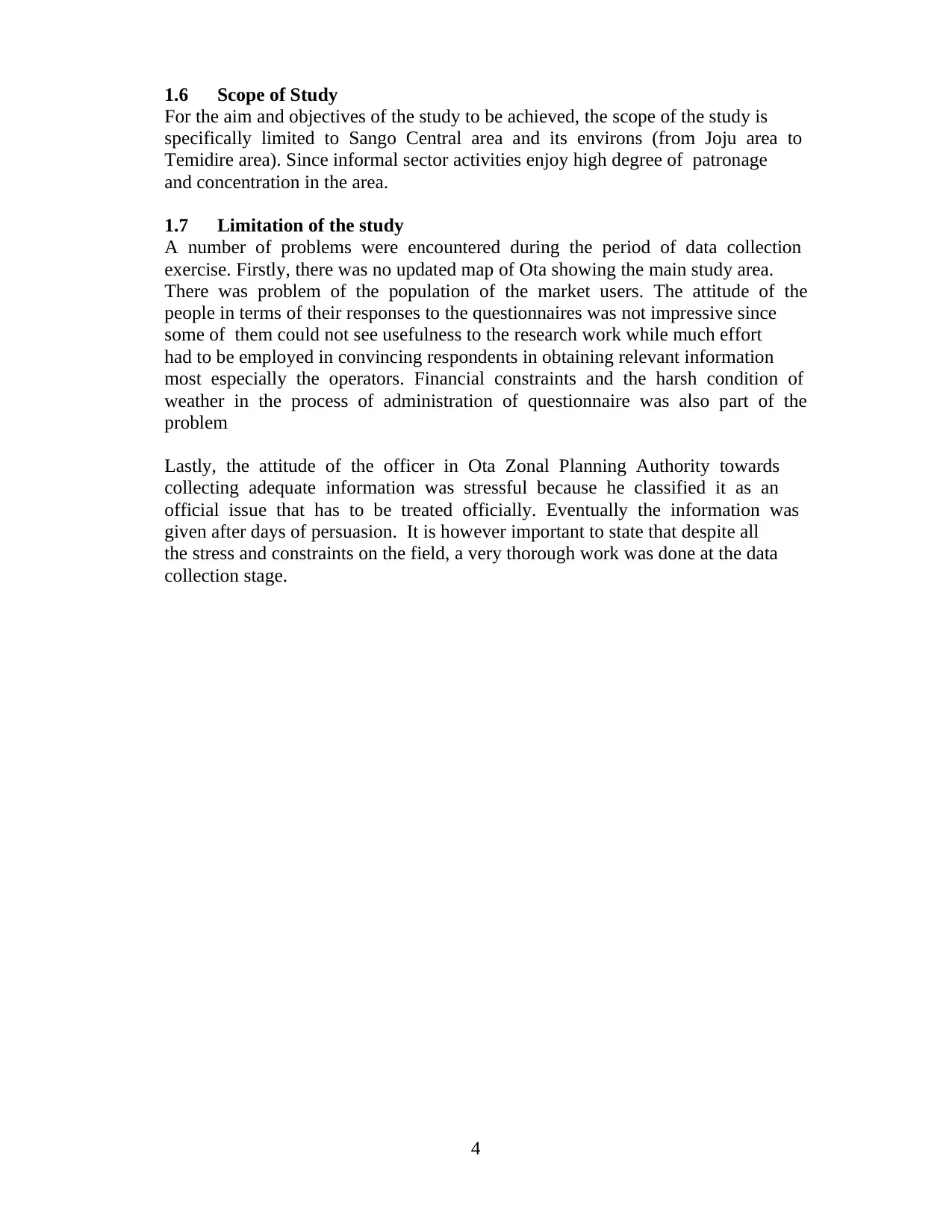
4
1.6 Scope of Study
For the aim and objectives of the study to be achieved, the scope of the study is
specifically limited to Sango Central area and its environs (from Joju area to
Temidire area). Since informal sector activities enjoy high degree of patronage
and concentration in the area.
1.7 Limitation of the study
A number of problems were encountered during the period of data collection
exercise. Firstly, there was no updated map of Ota showing the main study area.
There was problem of the population of the market users. The attitude of the
people in terms of their responses to the questionnaires was not impressive since
some of them could not see usefulness to the research work while much effort
had to be employed in convincing respondents in obtaining relevant information
most especially the operators. Financial constraints and the harsh condition of
weather in the process of administration of questionnaire was also part of the
problem
Lastly, the attitude of the officer in Ota Zonal Planning Authority towards
collecting adequate information was stressful because he classified it as an
official issue that has to be treated officially. Eventually the information was
given after days of persuasion. It is however important to state that despite all
the stress and constraints on the field, a very thorough work was done at the data
collection stage.
1.6 Scope of Study
For the aim and objectives of the study to be achieved, the scope of the study is
specifically limited to Sango Central area and its environs (from Joju area to
Temidire area). Since informal sector activities enjoy high degree of patronage
and concentration in the area.
1.7 Limitation of the study
A number of problems were encountered during the period of data collection
exercise. Firstly, there was no updated map of Ota showing the main study area.
There was problem of the population of the market users. The attitude of the
people in terms of their responses to the questionnaires was not impressive since
some of them could not see usefulness to the research work while much effort
had to be employed in convincing respondents in obtaining relevant information
most especially the operators. Financial constraints and the harsh condition of
weather in the process of administration of questionnaire was also part of the
problem
Lastly, the attitude of the officer in Ota Zonal Planning Authority towards
collecting adequate information was stressful because he classified it as an
official issue that has to be treated officially. Eventually the information was
given after days of persuasion. It is however important to state that despite all
the stress and constraints on the field, a very thorough work was done at the data
collection stage.
Paraphrase This Document
Need a fresh take? Get an instant paraphrase of this document with our AI Paraphraser
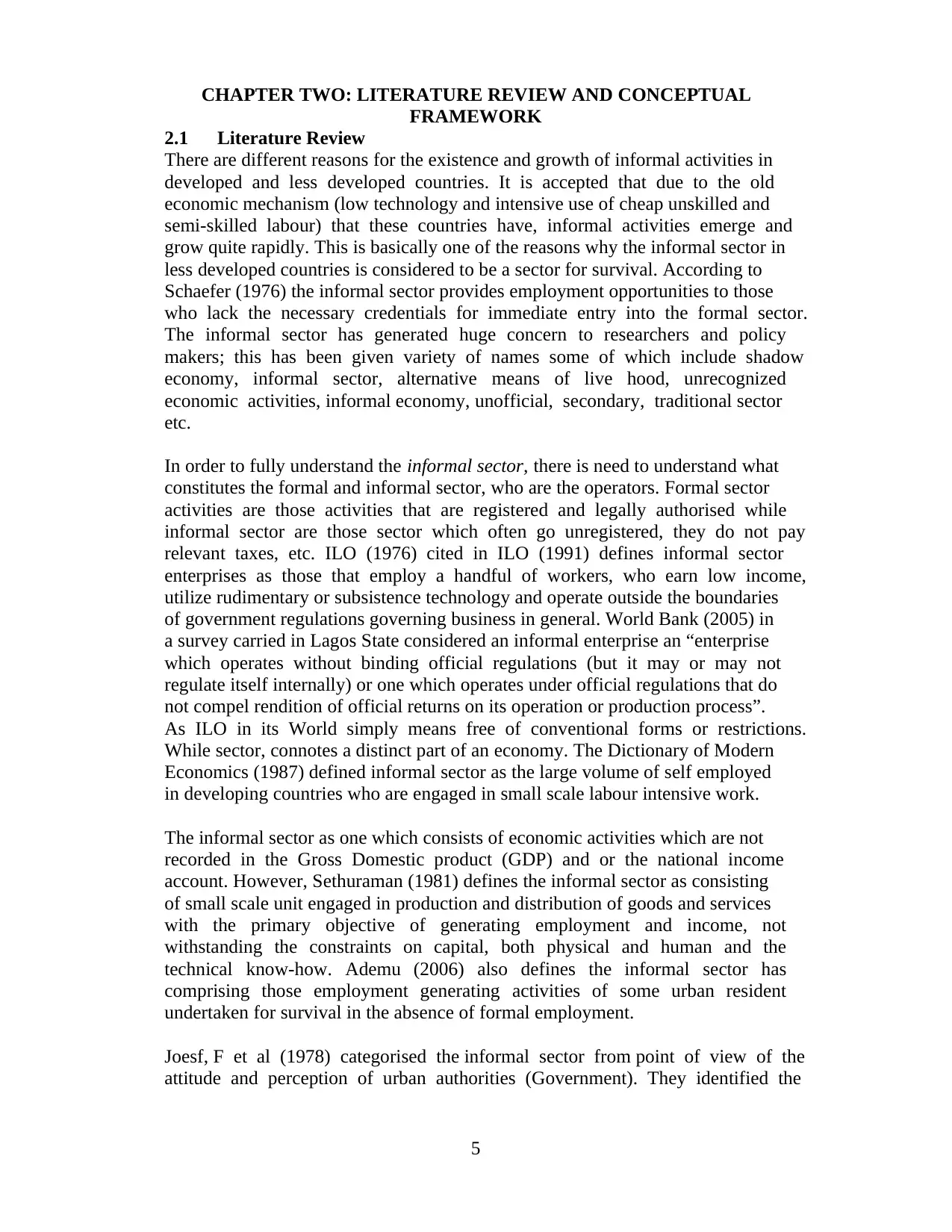
5
CHAPTER TWO: LITERATURE REVIEW AND CONCEPTUAL
FRAMEWORK
2.1 Literature Review
There are different reasons for the existence and growth of informal activities in
developed and less developed countries. It is accepted that due to the old
economic mechanism (low technology and intensive use of cheap unskilled and
semi-skilled labour) that these countries have, informal activities emerge and
grow quite rapidly. This is basically one of the reasons why the informal sector in
less developed countries is considered to be a sector for survival. According to
Schaefer (1976) the informal sector provides employment opportunities to those
who lack the necessary credentials for immediate entry into the formal sector.
The informal sector has generated huge concern to researchers and policy
makers; this has been given variety of names some of which include shadow
economy, informal sector, alternative means of live hood, unrecognized
economic activities, informal economy, unofficial, secondary, traditional sector
etc.
In order to fully understand the informal sector, there is need to understand what
constitutes the formal and informal sector, who are the operators. Formal sector
activities are those activities that are registered and legally authorised while
informal sector are those sector which often go unregistered, they do not pay
relevant taxes, etc. ILO (1976) cited in ILO (1991) defines informal sector
enterprises as those that employ a handful of workers, who earn low income,
utilize rudimentary or subsistence technology and operate outside the boundaries
of government regulations governing business in general. World Bank (2005) in
a survey carried in Lagos State considered an informal enterprise an “enterprise
which operates without binding official regulations (but it may or may not
regulate itself internally) or one which operates under official regulations that do
not compel rendition of official returns on its operation or production process”.
As ILO in its World simply means free of conventional forms or restrictions.
While sector, connotes a distinct part of an economy. The Dictionary of Modern
Economics (1987) defined informal sector as the large volume of self employed
in developing countries who are engaged in small scale labour intensive work.
The informal sector as one which consists of economic activities which are not
recorded in the Gross Domestic product (GDP) and or the national income
account. However, Sethuraman (1981) defines the informal sector as consisting
of small scale unit engaged in production and distribution of goods and services
with the primary objective of generating employment and income, not
withstanding the constraints on capital, both physical and human and the
technical know-how. Ademu (2006) also defines the informal sector has
comprising those employment generating activities of some urban resident
undertaken for survival in the absence of formal employment.
Joesf, F et al (1978) categorised the informal sector from point of view of the
attitude and perception of urban authorities (Government). They identified the
CHAPTER TWO: LITERATURE REVIEW AND CONCEPTUAL
FRAMEWORK
2.1 Literature Review
There are different reasons for the existence and growth of informal activities in
developed and less developed countries. It is accepted that due to the old
economic mechanism (low technology and intensive use of cheap unskilled and
semi-skilled labour) that these countries have, informal activities emerge and
grow quite rapidly. This is basically one of the reasons why the informal sector in
less developed countries is considered to be a sector for survival. According to
Schaefer (1976) the informal sector provides employment opportunities to those
who lack the necessary credentials for immediate entry into the formal sector.
The informal sector has generated huge concern to researchers and policy
makers; this has been given variety of names some of which include shadow
economy, informal sector, alternative means of live hood, unrecognized
economic activities, informal economy, unofficial, secondary, traditional sector
etc.
In order to fully understand the informal sector, there is need to understand what
constitutes the formal and informal sector, who are the operators. Formal sector
activities are those activities that are registered and legally authorised while
informal sector are those sector which often go unregistered, they do not pay
relevant taxes, etc. ILO (1976) cited in ILO (1991) defines informal sector
enterprises as those that employ a handful of workers, who earn low income,
utilize rudimentary or subsistence technology and operate outside the boundaries
of government regulations governing business in general. World Bank (2005) in
a survey carried in Lagos State considered an informal enterprise an “enterprise
which operates without binding official regulations (but it may or may not
regulate itself internally) or one which operates under official regulations that do
not compel rendition of official returns on its operation or production process”.
As ILO in its World simply means free of conventional forms or restrictions.
While sector, connotes a distinct part of an economy. The Dictionary of Modern
Economics (1987) defined informal sector as the large volume of self employed
in developing countries who are engaged in small scale labour intensive work.
The informal sector as one which consists of economic activities which are not
recorded in the Gross Domestic product (GDP) and or the national income
account. However, Sethuraman (1981) defines the informal sector as consisting
of small scale unit engaged in production and distribution of goods and services
with the primary objective of generating employment and income, not
withstanding the constraints on capital, both physical and human and the
technical know-how. Ademu (2006) also defines the informal sector has
comprising those employment generating activities of some urban resident
undertaken for survival in the absence of formal employment.
Joesf, F et al (1978) categorised the informal sector from point of view of the
attitude and perception of urban authorities (Government). They identified the
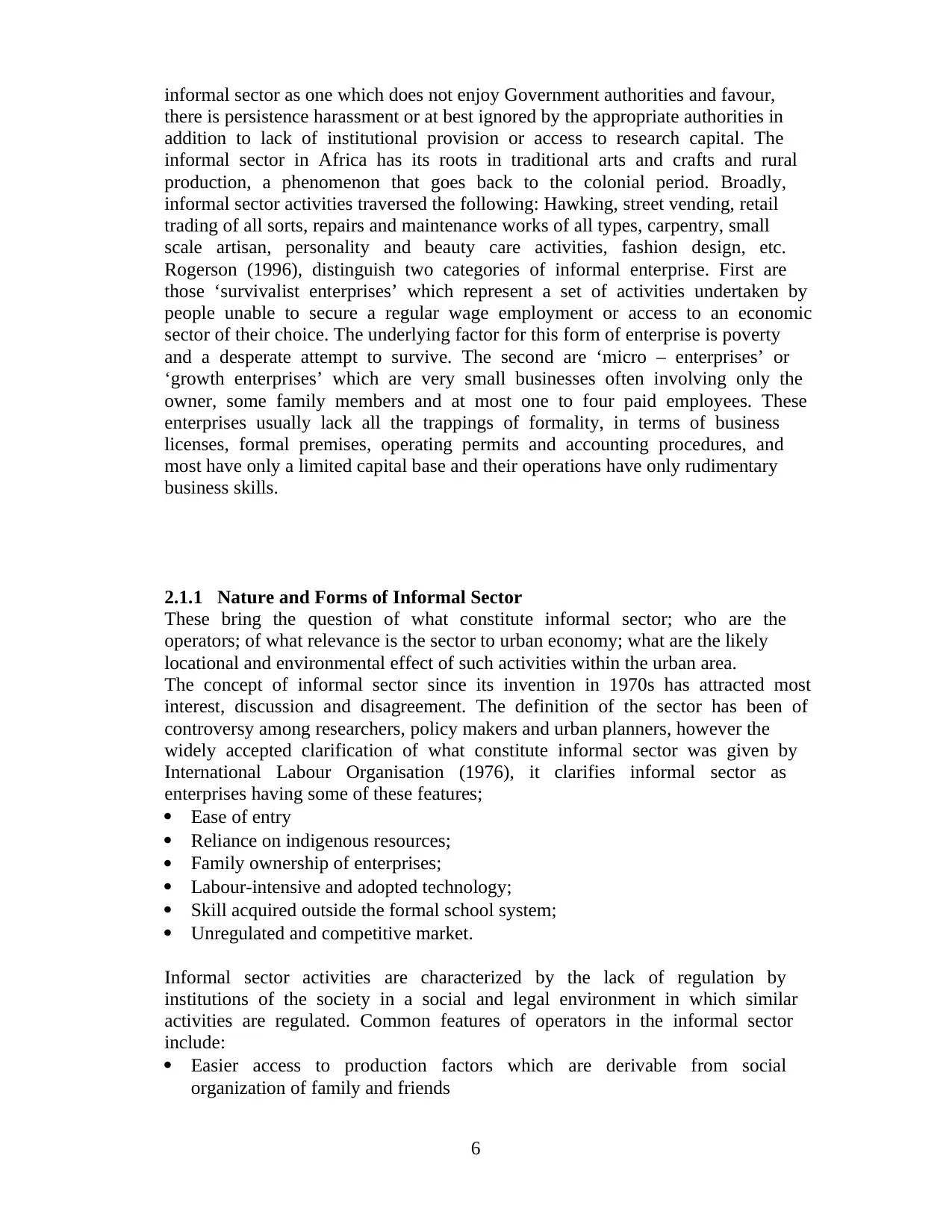
6
informal sector as one which does not enjoy Government authorities and favour,
there is persistence harassment or at best ignored by the appropriate authorities in
addition to lack of institutional provision or access to research capital. The
informal sector in Africa has its roots in traditional arts and crafts and rural
production, a phenomenon that goes back to the colonial period. Broadly,
informal sector activities traversed the following: Hawking, street vending, retail
trading of all sorts, repairs and maintenance works of all types, carpentry, small
scale artisan, personality and beauty care activities, fashion design, etc.
Rogerson (1996), distinguish two categories of informal enterprise. First are
those ‘survivalist enterprises’ which represent a set of activities undertaken by
people unable to secure a regular wage employment or access to an economic
sector of their choice. The underlying factor for this form of enterprise is poverty
and a desperate attempt to survive. The second are ‘micro – enterprises’ or
‘growth enterprises’ which are very small businesses often involving only the
owner, some family members and at most one to four paid employees. These
enterprises usually lack all the trappings of formality, in terms of business
licenses, formal premises, operating permits and accounting procedures, and
most have only a limited capital base and their operations have only rudimentary
business skills.
2.1.1 Nature and Forms of Informal Sector
These bring the question of what constitute informal sector; who are the
operators; of what relevance is the sector to urban economy; what are the likely
locational and environmental effect of such activities within the urban area.
The concept of informal sector since its invention in 1970s has attracted most
interest, discussion and disagreement. The definition of the sector has been of
controversy among researchers, policy makers and urban planners, however the
widely accepted clarification of what constitute informal sector was given by
International Labour Organisation (1976), it clarifies informal sector as
enterprises having some of these features;
Ease of entry
Reliance on indigenous resources;
Family ownership of enterprises;
Labour-intensive and adopted technology;
Skill acquired outside the formal school system;
Unregulated and competitive market.
Informal sector activities are characterized by the lack of regulation by
institutions of the society in a social and legal environment in which similar
activities are regulated. Common features of operators in the informal sector
include:
Easier access to production factors which are derivable from social
organization of family and friends
informal sector as one which does not enjoy Government authorities and favour,
there is persistence harassment or at best ignored by the appropriate authorities in
addition to lack of institutional provision or access to research capital. The
informal sector in Africa has its roots in traditional arts and crafts and rural
production, a phenomenon that goes back to the colonial period. Broadly,
informal sector activities traversed the following: Hawking, street vending, retail
trading of all sorts, repairs and maintenance works of all types, carpentry, small
scale artisan, personality and beauty care activities, fashion design, etc.
Rogerson (1996), distinguish two categories of informal enterprise. First are
those ‘survivalist enterprises’ which represent a set of activities undertaken by
people unable to secure a regular wage employment or access to an economic
sector of their choice. The underlying factor for this form of enterprise is poverty
and a desperate attempt to survive. The second are ‘micro – enterprises’ or
‘growth enterprises’ which are very small businesses often involving only the
owner, some family members and at most one to four paid employees. These
enterprises usually lack all the trappings of formality, in terms of business
licenses, formal premises, operating permits and accounting procedures, and
most have only a limited capital base and their operations have only rudimentary
business skills.
2.1.1 Nature and Forms of Informal Sector
These bring the question of what constitute informal sector; who are the
operators; of what relevance is the sector to urban economy; what are the likely
locational and environmental effect of such activities within the urban area.
The concept of informal sector since its invention in 1970s has attracted most
interest, discussion and disagreement. The definition of the sector has been of
controversy among researchers, policy makers and urban planners, however the
widely accepted clarification of what constitute informal sector was given by
International Labour Organisation (1976), it clarifies informal sector as
enterprises having some of these features;
Ease of entry
Reliance on indigenous resources;
Family ownership of enterprises;
Labour-intensive and adopted technology;
Skill acquired outside the formal school system;
Unregulated and competitive market.
Informal sector activities are characterized by the lack of regulation by
institutions of the society in a social and legal environment in which similar
activities are regulated. Common features of operators in the informal sector
include:
Easier access to production factors which are derivable from social
organization of family and friends
⊘ This is a preview!⊘
Do you want full access?
Subscribe today to unlock all pages.

Trusted by 1+ million students worldwide
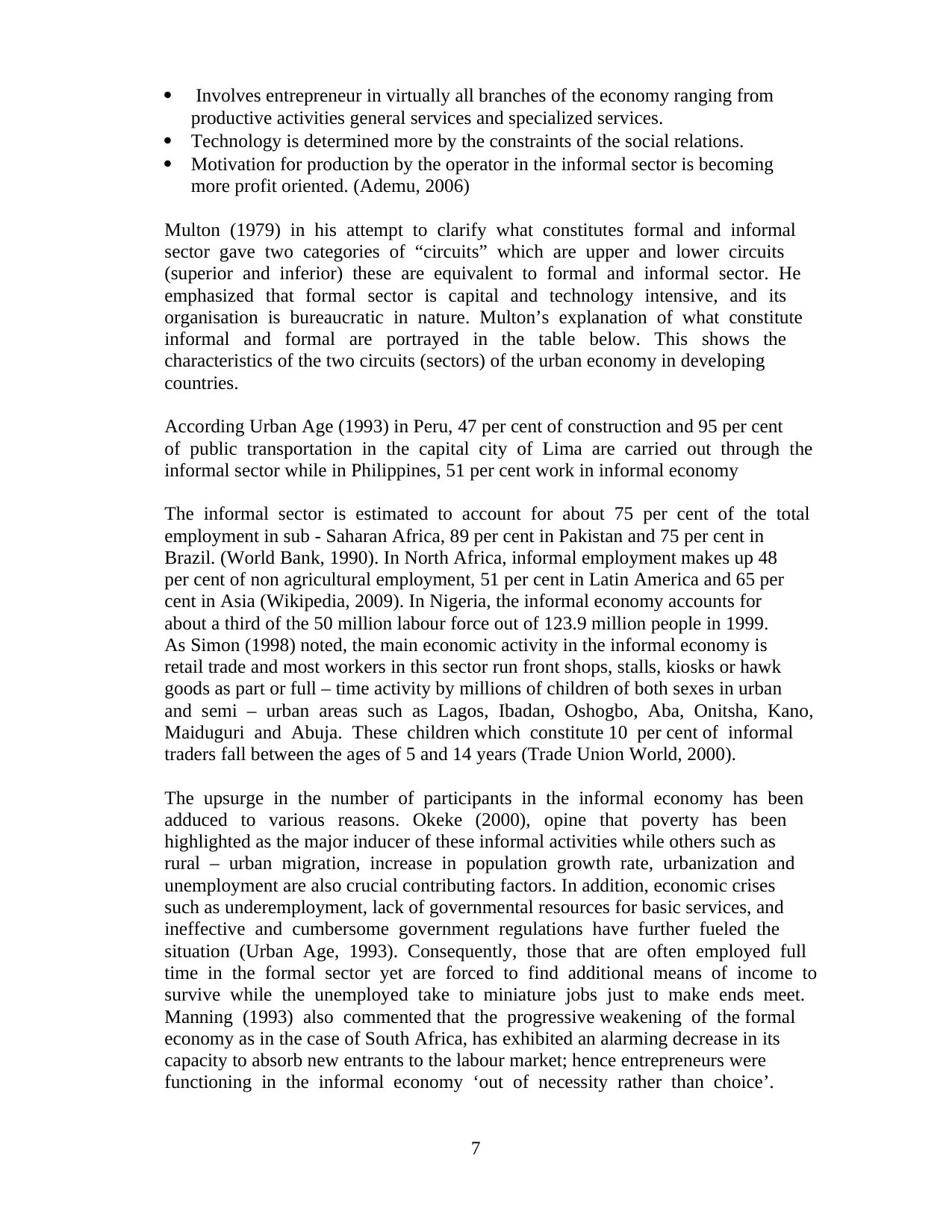
7
Involves entrepreneur in virtually all branches of the economy ranging from
productive activities general services and specialized services.
Technology is determined more by the constraints of the social relations.
Motivation for production by the operator in the informal sector is becoming
more profit oriented. (Ademu, 2006)
Multon (1979) in his attempt to clarify what constitutes formal and informal
sector gave two categories of “circuits” which are upper and lower circuits
(superior and inferior) these are equivalent to formal and informal sector. He
emphasized that formal sector is capital and technology intensive, and its
organisation is bureaucratic in nature. Multon’s explanation of what constitute
informal and formal are portrayed in the table below. This shows the
characteristics of the two circuits (sectors) of the urban economy in developing
countries.
According Urban Age (1993) in Peru, 47 per cent of construction and 95 per cent
of public transportation in the capital city of Lima are carried out through the
informal sector while in Philippines, 51 per cent work in informal economy
The informal sector is estimated to account for about 75 per cent of the total
employment in sub - Saharan Africa, 89 per cent in Pakistan and 75 per cent in
Brazil. (World Bank, 1990). In North Africa, informal employment makes up 48
per cent of non agricultural employment, 51 per cent in Latin America and 65 per
cent in Asia (Wikipedia, 2009). In Nigeria, the informal economy accounts for
about a third of the 50 million labour force out of 123.9 million people in 1999.
As Simon (1998) noted, the main economic activity in the informal economy is
retail trade and most workers in this sector run front shops, stalls, kiosks or hawk
goods as part or full – time activity by millions of children of both sexes in urban
and semi – urban areas such as Lagos, Ibadan, Oshogbo, Aba, Onitsha, Kano,
Maiduguri and Abuja. These children which constitute 10 per cent of informal
traders fall between the ages of 5 and 14 years (Trade Union World, 2000).
The upsurge in the number of participants in the informal economy has been
adduced to various reasons. Okeke (2000), opine that poverty has been
highlighted as the major inducer of these informal activities while others such as
rural – urban migration, increase in population growth rate, urbanization and
unemployment are also crucial contributing factors. In addition, economic crises
such as underemployment, lack of governmental resources for basic services, and
ineffective and cumbersome government regulations have further fueled the
situation (Urban Age, 1993). Consequently, those that are often employed full
time in the formal sector yet are forced to find additional means of income to
survive while the unemployed take to miniature jobs just to make ends meet.
Manning (1993) also commented that the progressive weakening of the formal
economy as in the case of South Africa, has exhibited an alarming decrease in its
capacity to absorb new entrants to the labour market; hence entrepreneurs were
functioning in the informal economy ‘out of necessity rather than choice’.
Involves entrepreneur in virtually all branches of the economy ranging from
productive activities general services and specialized services.
Technology is determined more by the constraints of the social relations.
Motivation for production by the operator in the informal sector is becoming
more profit oriented. (Ademu, 2006)
Multon (1979) in his attempt to clarify what constitutes formal and informal
sector gave two categories of “circuits” which are upper and lower circuits
(superior and inferior) these are equivalent to formal and informal sector. He
emphasized that formal sector is capital and technology intensive, and its
organisation is bureaucratic in nature. Multon’s explanation of what constitute
informal and formal are portrayed in the table below. This shows the
characteristics of the two circuits (sectors) of the urban economy in developing
countries.
According Urban Age (1993) in Peru, 47 per cent of construction and 95 per cent
of public transportation in the capital city of Lima are carried out through the
informal sector while in Philippines, 51 per cent work in informal economy
The informal sector is estimated to account for about 75 per cent of the total
employment in sub - Saharan Africa, 89 per cent in Pakistan and 75 per cent in
Brazil. (World Bank, 1990). In North Africa, informal employment makes up 48
per cent of non agricultural employment, 51 per cent in Latin America and 65 per
cent in Asia (Wikipedia, 2009). In Nigeria, the informal economy accounts for
about a third of the 50 million labour force out of 123.9 million people in 1999.
As Simon (1998) noted, the main economic activity in the informal economy is
retail trade and most workers in this sector run front shops, stalls, kiosks or hawk
goods as part or full – time activity by millions of children of both sexes in urban
and semi – urban areas such as Lagos, Ibadan, Oshogbo, Aba, Onitsha, Kano,
Maiduguri and Abuja. These children which constitute 10 per cent of informal
traders fall between the ages of 5 and 14 years (Trade Union World, 2000).
The upsurge in the number of participants in the informal economy has been
adduced to various reasons. Okeke (2000), opine that poverty has been
highlighted as the major inducer of these informal activities while others such as
rural – urban migration, increase in population growth rate, urbanization and
unemployment are also crucial contributing factors. In addition, economic crises
such as underemployment, lack of governmental resources for basic services, and
ineffective and cumbersome government regulations have further fueled the
situation (Urban Age, 1993). Consequently, those that are often employed full
time in the formal sector yet are forced to find additional means of income to
survive while the unemployed take to miniature jobs just to make ends meet.
Manning (1993) also commented that the progressive weakening of the formal
economy as in the case of South Africa, has exhibited an alarming decrease in its
capacity to absorb new entrants to the labour market; hence entrepreneurs were
functioning in the informal economy ‘out of necessity rather than choice’.
Paraphrase This Document
Need a fresh take? Get an instant paraphrase of this document with our AI Paraphraser
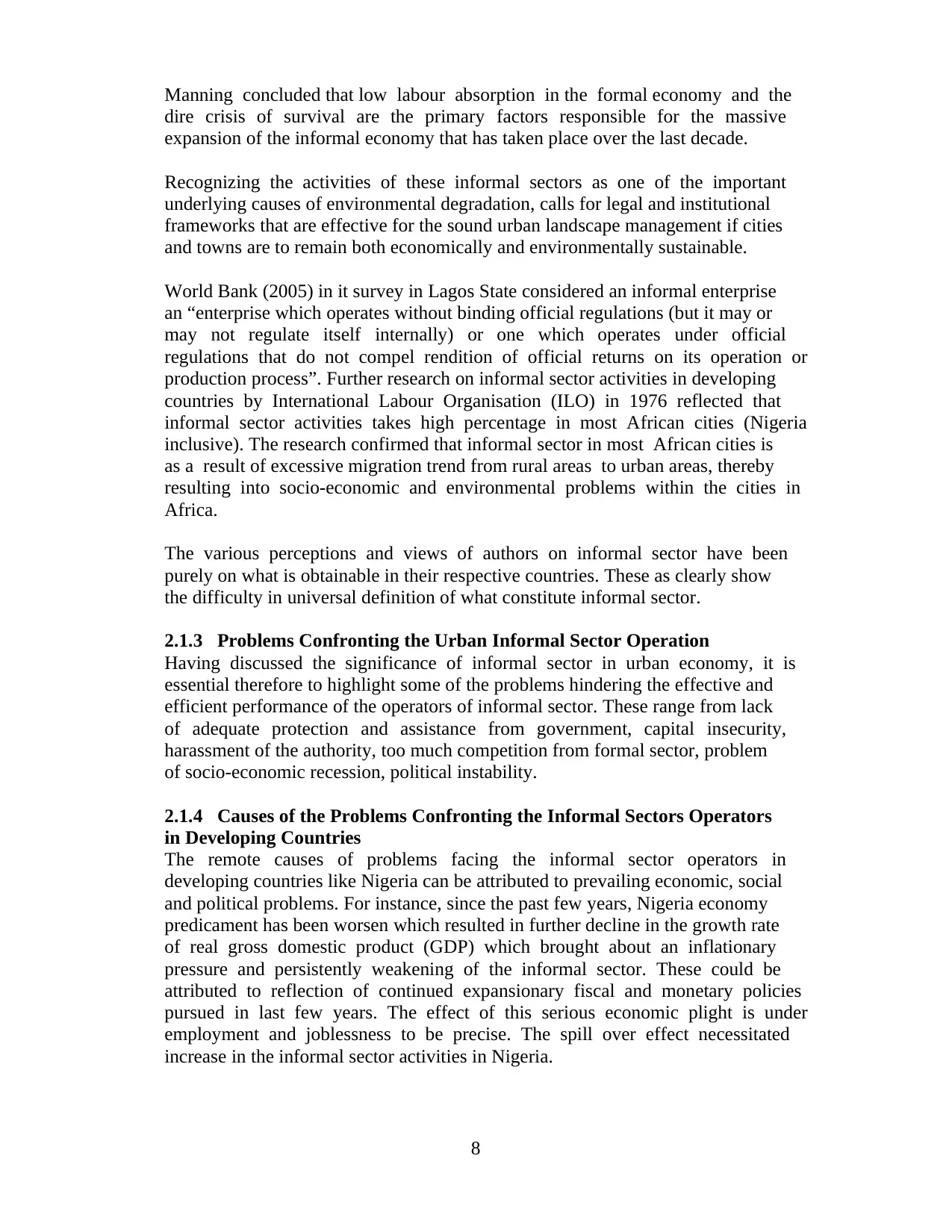
8
Manning concluded that low labour absorption in the formal economy and the
dire crisis of survival are the primary factors responsible for the massive
expansion of the informal economy that has taken place over the last decade.
Recognizing the activities of these informal sectors as one of the important
underlying causes of environmental degradation, calls for legal and institutional
frameworks that are effective for the sound urban landscape management if cities
and towns are to remain both economically and environmentally sustainable.
World Bank (2005) in it survey in Lagos State considered an informal enterprise
an “enterprise which operates without binding official regulations (but it may or
may not regulate itself internally) or one which operates under official
regulations that do not compel rendition of official returns on its operation or
production process”. Further research on informal sector activities in developing
countries by International Labour Organisation (ILO) in 1976 reflected that
informal sector activities takes high percentage in most African cities (Nigeria
inclusive). The research confirmed that informal sector in most African cities is
as a result of excessive migration trend from rural areas to urban areas, thereby
resulting into socio-economic and environmental problems within the cities in
Africa.
The various perceptions and views of authors on informal sector have been
purely on what is obtainable in their respective countries. These as clearly show
the difficulty in universal definition of what constitute informal sector.
2.1.3 Problems Confronting the Urban Informal Sector Operation
Having discussed the significance of informal sector in urban economy, it is
essential therefore to highlight some of the problems hindering the effective and
efficient performance of the operators of informal sector. These range from lack
of adequate protection and assistance from government, capital insecurity,
harassment of the authority, too much competition from formal sector, problem
of socio-economic recession, political instability.
2.1.4 Causes of the Problems Confronting the Informal Sectors Operators
in Developing Countries
The remote causes of problems facing the informal sector operators in
developing countries like Nigeria can be attributed to prevailing economic, social
and political problems. For instance, since the past few years, Nigeria economy
predicament has been worsen which resulted in further decline in the growth rate
of real gross domestic product (GDP) which brought about an inflationary
pressure and persistently weakening of the informal sector. These could be
attributed to reflection of continued expansionary fiscal and monetary policies
pursued in last few years. The effect of this serious economic plight is under
employment and joblessness to be precise. The spill over effect necessitated
increase in the informal sector activities in Nigeria.
Manning concluded that low labour absorption in the formal economy and the
dire crisis of survival are the primary factors responsible for the massive
expansion of the informal economy that has taken place over the last decade.
Recognizing the activities of these informal sectors as one of the important
underlying causes of environmental degradation, calls for legal and institutional
frameworks that are effective for the sound urban landscape management if cities
and towns are to remain both economically and environmentally sustainable.
World Bank (2005) in it survey in Lagos State considered an informal enterprise
an “enterprise which operates without binding official regulations (but it may or
may not regulate itself internally) or one which operates under official
regulations that do not compel rendition of official returns on its operation or
production process”. Further research on informal sector activities in developing
countries by International Labour Organisation (ILO) in 1976 reflected that
informal sector activities takes high percentage in most African cities (Nigeria
inclusive). The research confirmed that informal sector in most African cities is
as a result of excessive migration trend from rural areas to urban areas, thereby
resulting into socio-economic and environmental problems within the cities in
Africa.
The various perceptions and views of authors on informal sector have been
purely on what is obtainable in their respective countries. These as clearly show
the difficulty in universal definition of what constitute informal sector.
2.1.3 Problems Confronting the Urban Informal Sector Operation
Having discussed the significance of informal sector in urban economy, it is
essential therefore to highlight some of the problems hindering the effective and
efficient performance of the operators of informal sector. These range from lack
of adequate protection and assistance from government, capital insecurity,
harassment of the authority, too much competition from formal sector, problem
of socio-economic recession, political instability.
2.1.4 Causes of the Problems Confronting the Informal Sectors Operators
in Developing Countries
The remote causes of problems facing the informal sector operators in
developing countries like Nigeria can be attributed to prevailing economic, social
and political problems. For instance, since the past few years, Nigeria economy
predicament has been worsen which resulted in further decline in the growth rate
of real gross domestic product (GDP) which brought about an inflationary
pressure and persistently weakening of the informal sector. These could be
attributed to reflection of continued expansionary fiscal and monetary policies
pursued in last few years. The effect of this serious economic plight is under
employment and joblessness to be precise. The spill over effect necessitated
increase in the informal sector activities in Nigeria.
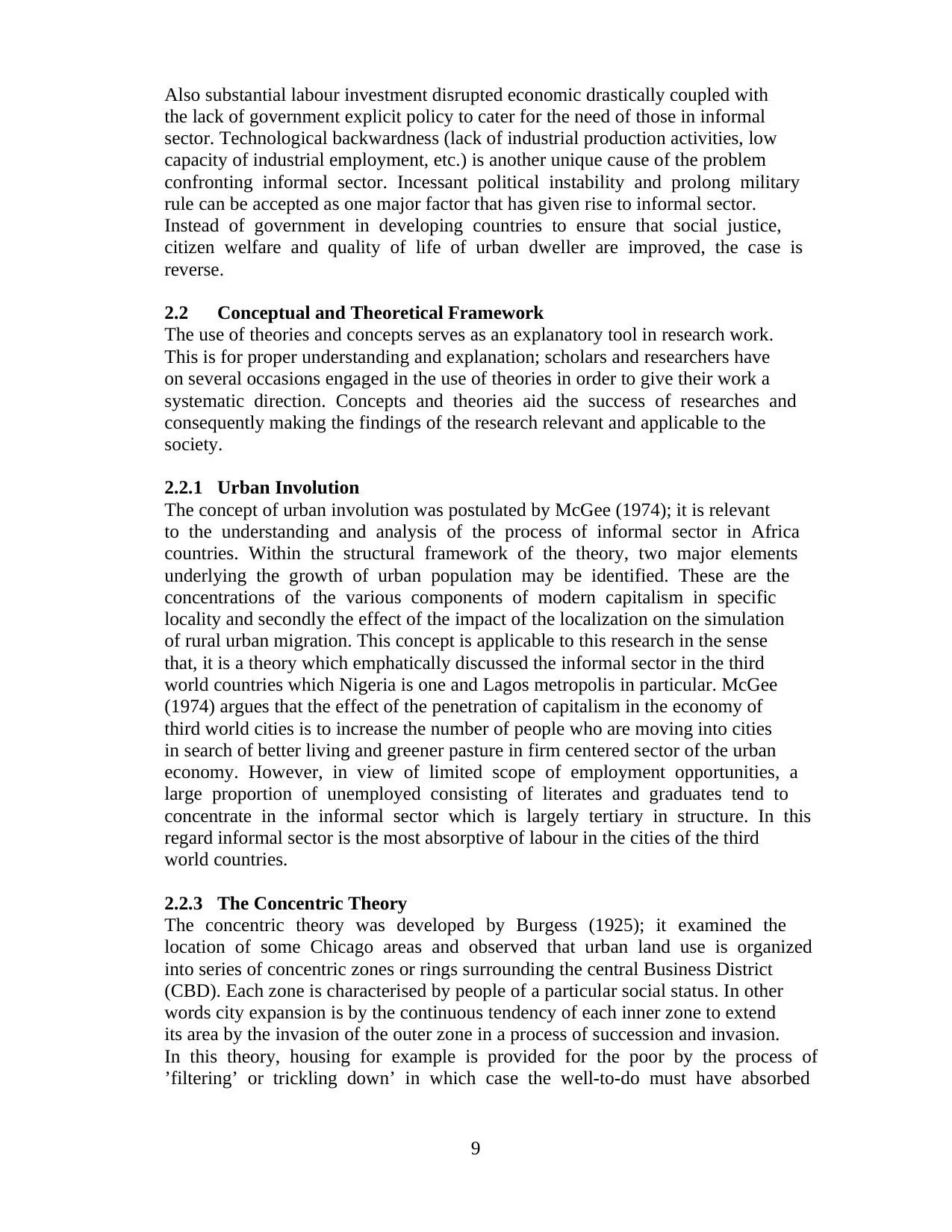
9
Also substantial labour investment disrupted economic drastically coupled with
the lack of government explicit policy to cater for the need of those in informal
sector. Technological backwardness (lack of industrial production activities, low
capacity of industrial employment, etc.) is another unique cause of the problem
confronting informal sector. Incessant political instability and prolong military
rule can be accepted as one major factor that has given rise to informal sector.
Instead of government in developing countries to ensure that social justice,
citizen welfare and quality of life of urban dweller are improved, the case is
reverse.
2.2 Conceptual and Theoretical Framework
The use of theories and concepts serves as an explanatory tool in research work.
This is for proper understanding and explanation; scholars and researchers have
on several occasions engaged in the use of theories in order to give their work a
systematic direction. Concepts and theories aid the success of researches and
consequently making the findings of the research relevant and applicable to the
society.
2.2.1 Urban Involution
The concept of urban involution was postulated by McGee (1974); it is relevant
to the understanding and analysis of the process of informal sector in Africa
countries. Within the structural framework of the theory, two major elements
underlying the growth of urban population may be identified. These are the
concentrations of the various components of modern capitalism in specific
locality and secondly the effect of the impact of the localization on the simulation
of rural urban migration. This concept is applicable to this research in the sense
that, it is a theory which emphatically discussed the informal sector in the third
world countries which Nigeria is one and Lagos metropolis in particular. McGee
(1974) argues that the effect of the penetration of capitalism in the economy of
third world cities is to increase the number of people who are moving into cities
in search of better living and greener pasture in firm centered sector of the urban
economy. However, in view of limited scope of employment opportunities, a
large proportion of unemployed consisting of literates and graduates tend to
concentrate in the informal sector which is largely tertiary in structure. In this
regard informal sector is the most absorptive of labour in the cities of the third
world countries.
2.2.3 The Concentric Theory
The concentric theory was developed by Burgess (1925); it examined the
location of some Chicago areas and observed that urban land use is organized
into series of concentric zones or rings surrounding the central Business District
(CBD). Each zone is characterised by people of a particular social status. In other
words city expansion is by the continuous tendency of each inner zone to extend
its area by the invasion of the outer zone in a process of succession and invasion.
In this theory, housing for example is provided for the poor by the process of
’filtering’ or trickling down’ in which case the well-to-do must have absorbed
Also substantial labour investment disrupted economic drastically coupled with
the lack of government explicit policy to cater for the need of those in informal
sector. Technological backwardness (lack of industrial production activities, low
capacity of industrial employment, etc.) is another unique cause of the problem
confronting informal sector. Incessant political instability and prolong military
rule can be accepted as one major factor that has given rise to informal sector.
Instead of government in developing countries to ensure that social justice,
citizen welfare and quality of life of urban dweller are improved, the case is
reverse.
2.2 Conceptual and Theoretical Framework
The use of theories and concepts serves as an explanatory tool in research work.
This is for proper understanding and explanation; scholars and researchers have
on several occasions engaged in the use of theories in order to give their work a
systematic direction. Concepts and theories aid the success of researches and
consequently making the findings of the research relevant and applicable to the
society.
2.2.1 Urban Involution
The concept of urban involution was postulated by McGee (1974); it is relevant
to the understanding and analysis of the process of informal sector in Africa
countries. Within the structural framework of the theory, two major elements
underlying the growth of urban population may be identified. These are the
concentrations of the various components of modern capitalism in specific
locality and secondly the effect of the impact of the localization on the simulation
of rural urban migration. This concept is applicable to this research in the sense
that, it is a theory which emphatically discussed the informal sector in the third
world countries which Nigeria is one and Lagos metropolis in particular. McGee
(1974) argues that the effect of the penetration of capitalism in the economy of
third world cities is to increase the number of people who are moving into cities
in search of better living and greener pasture in firm centered sector of the urban
economy. However, in view of limited scope of employment opportunities, a
large proportion of unemployed consisting of literates and graduates tend to
concentrate in the informal sector which is largely tertiary in structure. In this
regard informal sector is the most absorptive of labour in the cities of the third
world countries.
2.2.3 The Concentric Theory
The concentric theory was developed by Burgess (1925); it examined the
location of some Chicago areas and observed that urban land use is organized
into series of concentric zones or rings surrounding the central Business District
(CBD). Each zone is characterised by people of a particular social status. In other
words city expansion is by the continuous tendency of each inner zone to extend
its area by the invasion of the outer zone in a process of succession and invasion.
In this theory, housing for example is provided for the poor by the process of
’filtering’ or trickling down’ in which case the well-to-do must have absorbed
⊘ This is a preview!⊘
Do you want full access?
Subscribe today to unlock all pages.

Trusted by 1+ million students worldwide
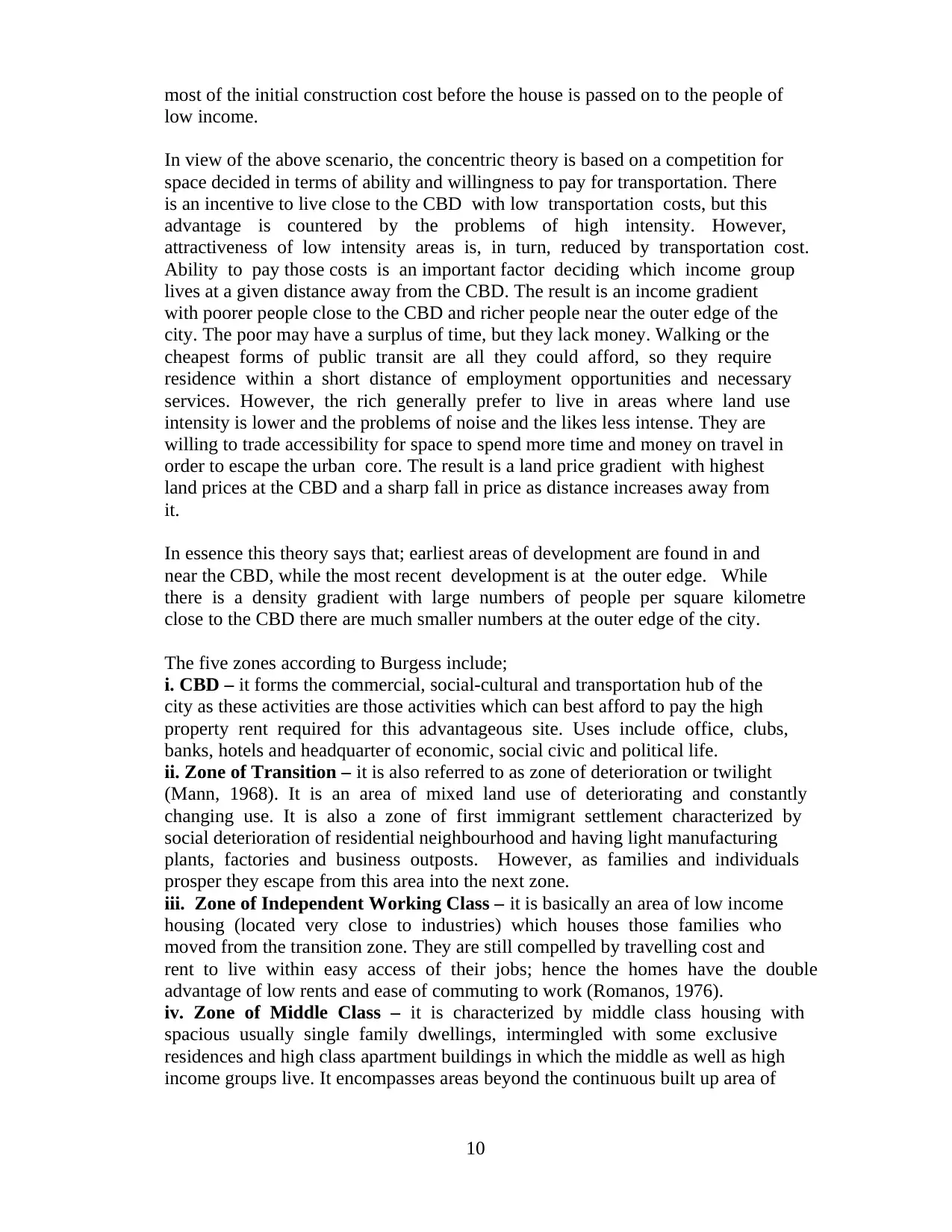
10
most of the initial construction cost before the house is passed on to the people of
low income.
In view of the above scenario, the concentric theory is based on a competition for
space decided in terms of ability and willingness to pay for transportation. There
is an incentive to live close to the CBD with low transportation costs, but this
advantage is countered by the problems of high intensity. However,
attractiveness of low intensity areas is, in turn, reduced by transportation cost.
Ability to pay those costs is an important factor deciding which income group
lives at a given distance away from the CBD. The result is an income gradient
with poorer people close to the CBD and richer people near the outer edge of the
city. The poor may have a surplus of time, but they lack money. Walking or the
cheapest forms of public transit are all they could afford, so they require
residence within a short distance of employment opportunities and necessary
services. However, the rich generally prefer to live in areas where land use
intensity is lower and the problems of noise and the likes less intense. They are
willing to trade accessibility for space to spend more time and money on travel in
order to escape the urban core. The result is a land price gradient with highest
land prices at the CBD and a sharp fall in price as distance increases away from
it.
In essence this theory says that; earliest areas of development are found in and
near the CBD, while the most recent development is at the outer edge. While
there is a density gradient with large numbers of people per square kilometre
close to the CBD there are much smaller numbers at the outer edge of the city.
The five zones according to Burgess include;
i. CBD – it forms the commercial, social-cultural and transportation hub of the
city as these activities are those activities which can best afford to pay the high
property rent required for this advantageous site. Uses include office, clubs,
banks, hotels and headquarter of economic, social civic and political life.
ii. Zone of Transition – it is also referred to as zone of deterioration or twilight
(Mann, 1968). It is an area of mixed land use of deteriorating and constantly
changing use. It is also a zone of first immigrant settlement characterized by
social deterioration of residential neighbourhood and having light manufacturing
plants, factories and business outposts. However, as families and individuals
prosper they escape from this area into the next zone.
iii. Zone of Independent Working Class – it is basically an area of low income
housing (located very close to industries) which houses those families who
moved from the transition zone. They are still compelled by travelling cost and
rent to live within easy access of their jobs; hence the homes have the double
advantage of low rents and ease of commuting to work (Romanos, 1976).
iv. Zone of Middle Class – it is characterized by middle class housing with
spacious usually single family dwellings, intermingled with some exclusive
residences and high class apartment buildings in which the middle as well as high
income groups live. It encompasses areas beyond the continuous built up area of
most of the initial construction cost before the house is passed on to the people of
low income.
In view of the above scenario, the concentric theory is based on a competition for
space decided in terms of ability and willingness to pay for transportation. There
is an incentive to live close to the CBD with low transportation costs, but this
advantage is countered by the problems of high intensity. However,
attractiveness of low intensity areas is, in turn, reduced by transportation cost.
Ability to pay those costs is an important factor deciding which income group
lives at a given distance away from the CBD. The result is an income gradient
with poorer people close to the CBD and richer people near the outer edge of the
city. The poor may have a surplus of time, but they lack money. Walking or the
cheapest forms of public transit are all they could afford, so they require
residence within a short distance of employment opportunities and necessary
services. However, the rich generally prefer to live in areas where land use
intensity is lower and the problems of noise and the likes less intense. They are
willing to trade accessibility for space to spend more time and money on travel in
order to escape the urban core. The result is a land price gradient with highest
land prices at the CBD and a sharp fall in price as distance increases away from
it.
In essence this theory says that; earliest areas of development are found in and
near the CBD, while the most recent development is at the outer edge. While
there is a density gradient with large numbers of people per square kilometre
close to the CBD there are much smaller numbers at the outer edge of the city.
The five zones according to Burgess include;
i. CBD – it forms the commercial, social-cultural and transportation hub of the
city as these activities are those activities which can best afford to pay the high
property rent required for this advantageous site. Uses include office, clubs,
banks, hotels and headquarter of economic, social civic and political life.
ii. Zone of Transition – it is also referred to as zone of deterioration or twilight
(Mann, 1968). It is an area of mixed land use of deteriorating and constantly
changing use. It is also a zone of first immigrant settlement characterized by
social deterioration of residential neighbourhood and having light manufacturing
plants, factories and business outposts. However, as families and individuals
prosper they escape from this area into the next zone.
iii. Zone of Independent Working Class – it is basically an area of low income
housing (located very close to industries) which houses those families who
moved from the transition zone. They are still compelled by travelling cost and
rent to live within easy access of their jobs; hence the homes have the double
advantage of low rents and ease of commuting to work (Romanos, 1976).
iv. Zone of Middle Class – it is characterized by middle class housing with
spacious usually single family dwellings, intermingled with some exclusive
residences and high class apartment buildings in which the middle as well as high
income groups live. It encompasses areas beyond the continuous built up area of
Paraphrase This Document
Need a fresh take? Get an instant paraphrase of this document with our AI Paraphraser
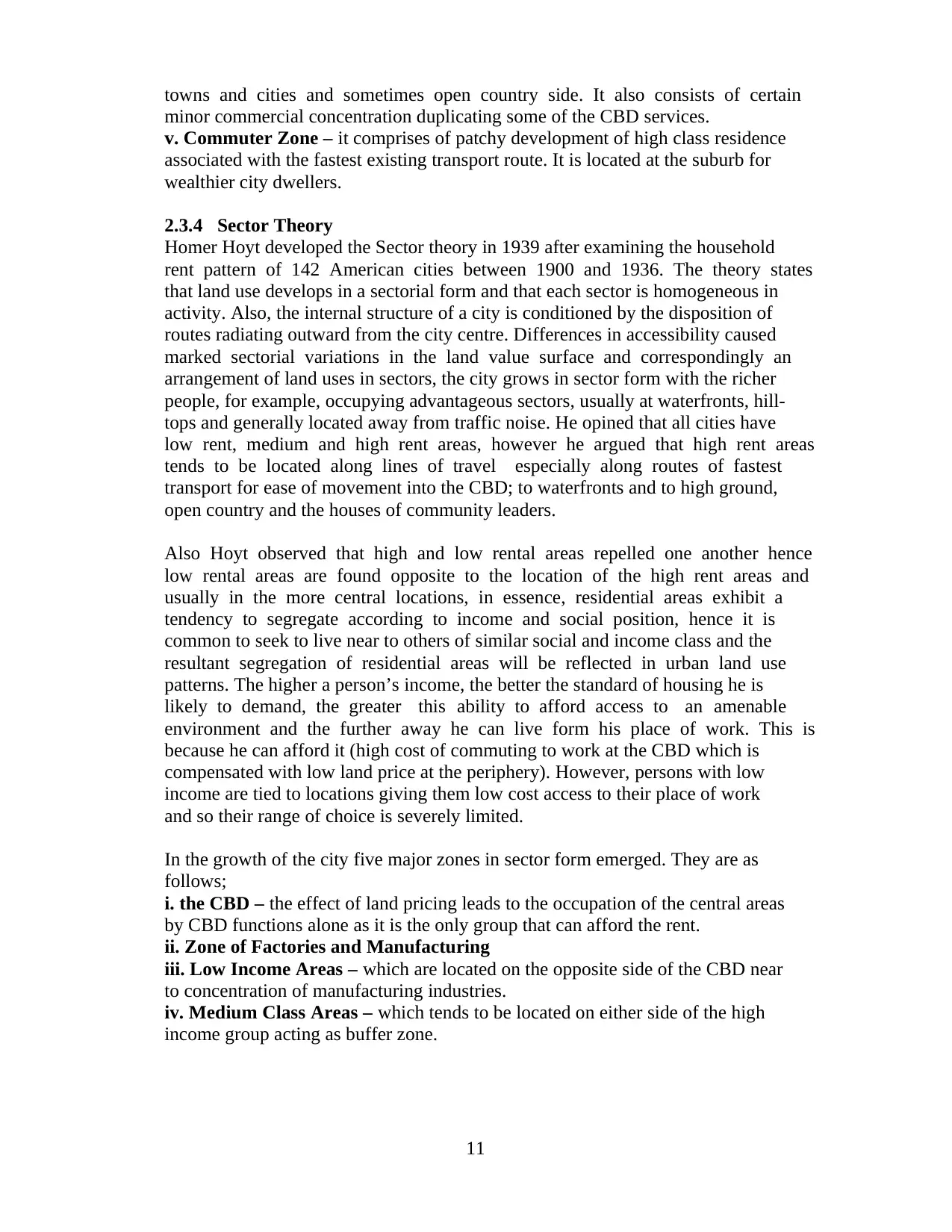
11
towns and cities and sometimes open country side. It also consists of certain
minor commercial concentration duplicating some of the CBD services.
v. Commuter Zone – it comprises of patchy development of high class residence
associated with the fastest existing transport route. It is located at the suburb for
wealthier city dwellers.
2.3.4 Sector Theory
Homer Hoyt developed the Sector theory in 1939 after examining the household
rent pattern of 142 American cities between 1900 and 1936. The theory states
that land use develops in a sectorial form and that each sector is homogeneous in
activity. Also, the internal structure of a city is conditioned by the disposition of
routes radiating outward from the city centre. Differences in accessibility caused
marked sectorial variations in the land value surface and correspondingly an
arrangement of land uses in sectors, the city grows in sector form with the richer
people, for example, occupying advantageous sectors, usually at waterfronts, hill-
tops and generally located away from traffic noise. He opined that all cities have
low rent, medium and high rent areas, however he argued that high rent areas
tends to be located along lines of travel especially along routes of fastest
transport for ease of movement into the CBD; to waterfronts and to high ground,
open country and the houses of community leaders.
Also Hoyt observed that high and low rental areas repelled one another hence
low rental areas are found opposite to the location of the high rent areas and
usually in the more central locations, in essence, residential areas exhibit a
tendency to segregate according to income and social position, hence it is
common to seek to live near to others of similar social and income class and the
resultant segregation of residential areas will be reflected in urban land use
patterns. The higher a person’s income, the better the standard of housing he is
likely to demand, the greater this ability to afford access to an amenable
environment and the further away he can live form his place of work. This is
because he can afford it (high cost of commuting to work at the CBD which is
compensated with low land price at the periphery). However, persons with low
income are tied to locations giving them low cost access to their place of work
and so their range of choice is severely limited.
In the growth of the city five major zones in sector form emerged. They are as
follows;
i. the CBD – the effect of land pricing leads to the occupation of the central areas
by CBD functions alone as it is the only group that can afford the rent.
ii. Zone of Factories and Manufacturing
iii. Low Income Areas – which are located on the opposite side of the CBD near
to concentration of manufacturing industries.
iv. Medium Class Areas – which tends to be located on either side of the high
income group acting as buffer zone.
towns and cities and sometimes open country side. It also consists of certain
minor commercial concentration duplicating some of the CBD services.
v. Commuter Zone – it comprises of patchy development of high class residence
associated with the fastest existing transport route. It is located at the suburb for
wealthier city dwellers.
2.3.4 Sector Theory
Homer Hoyt developed the Sector theory in 1939 after examining the household
rent pattern of 142 American cities between 1900 and 1936. The theory states
that land use develops in a sectorial form and that each sector is homogeneous in
activity. Also, the internal structure of a city is conditioned by the disposition of
routes radiating outward from the city centre. Differences in accessibility caused
marked sectorial variations in the land value surface and correspondingly an
arrangement of land uses in sectors, the city grows in sector form with the richer
people, for example, occupying advantageous sectors, usually at waterfronts, hill-
tops and generally located away from traffic noise. He opined that all cities have
low rent, medium and high rent areas, however he argued that high rent areas
tends to be located along lines of travel especially along routes of fastest
transport for ease of movement into the CBD; to waterfronts and to high ground,
open country and the houses of community leaders.
Also Hoyt observed that high and low rental areas repelled one another hence
low rental areas are found opposite to the location of the high rent areas and
usually in the more central locations, in essence, residential areas exhibit a
tendency to segregate according to income and social position, hence it is
common to seek to live near to others of similar social and income class and the
resultant segregation of residential areas will be reflected in urban land use
patterns. The higher a person’s income, the better the standard of housing he is
likely to demand, the greater this ability to afford access to an amenable
environment and the further away he can live form his place of work. This is
because he can afford it (high cost of commuting to work at the CBD which is
compensated with low land price at the periphery). However, persons with low
income are tied to locations giving them low cost access to their place of work
and so their range of choice is severely limited.
In the growth of the city five major zones in sector form emerged. They are as
follows;
i. the CBD – the effect of land pricing leads to the occupation of the central areas
by CBD functions alone as it is the only group that can afford the rent.
ii. Zone of Factories and Manufacturing
iii. Low Income Areas – which are located on the opposite side of the CBD near
to concentration of manufacturing industries.
iv. Medium Class Areas – which tends to be located on either side of the high
income group acting as buffer zone.
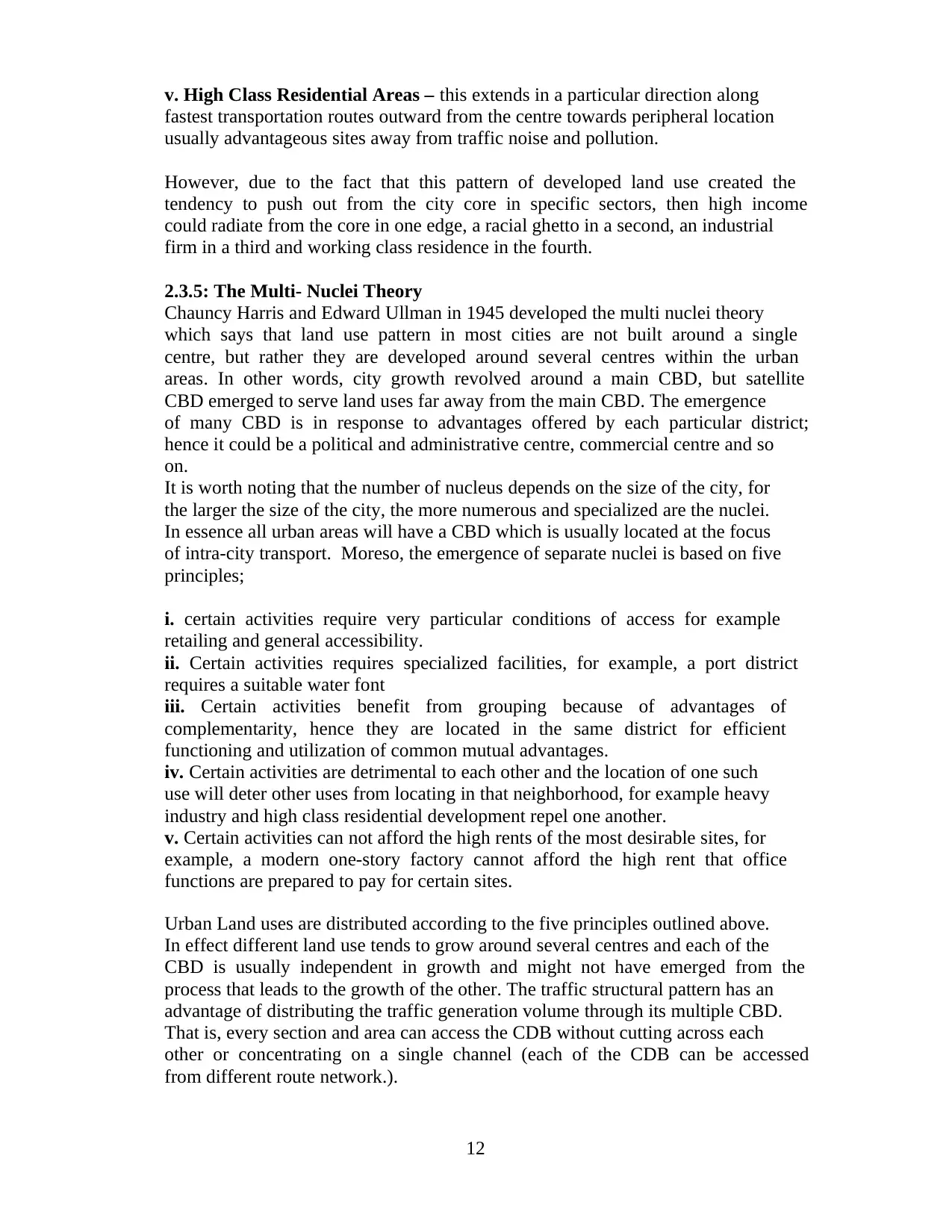
12
v. High Class Residential Areas – this extends in a particular direction along
fastest transportation routes outward from the centre towards peripheral location
usually advantageous sites away from traffic noise and pollution.
However, due to the fact that this pattern of developed land use created the
tendency to push out from the city core in specific sectors, then high income
could radiate from the core in one edge, a racial ghetto in a second, an industrial
firm in a third and working class residence in the fourth.
2.3.5: The Multi- Nuclei Theory
Chauncy Harris and Edward Ullman in 1945 developed the multi nuclei theory
which says that land use pattern in most cities are not built around a single
centre, but rather they are developed around several centres within the urban
areas. In other words, city growth revolved around a main CBD, but satellite
CBD emerged to serve land uses far away from the main CBD. The emergence
of many CBD is in response to advantages offered by each particular district;
hence it could be a political and administrative centre, commercial centre and so
on.
It is worth noting that the number of nucleus depends on the size of the city, for
the larger the size of the city, the more numerous and specialized are the nuclei.
In essence all urban areas will have a CBD which is usually located at the focus
of intra-city transport. Moreso, the emergence of separate nuclei is based on five
principles;
i. certain activities require very particular conditions of access for example
retailing and general accessibility.
ii. Certain activities requires specialized facilities, for example, a port district
requires a suitable water font
iii. Certain activities benefit from grouping because of advantages of
complementarity, hence they are located in the same district for efficient
functioning and utilization of common mutual advantages.
iv. Certain activities are detrimental to each other and the location of one such
use will deter other uses from locating in that neighborhood, for example heavy
industry and high class residential development repel one another.
v. Certain activities can not afford the high rents of the most desirable sites, for
example, a modern one-story factory cannot afford the high rent that office
functions are prepared to pay for certain sites.
Urban Land uses are distributed according to the five principles outlined above.
In effect different land use tends to grow around several centres and each of the
CBD is usually independent in growth and might not have emerged from the
process that leads to the growth of the other. The traffic structural pattern has an
advantage of distributing the traffic generation volume through its multiple CBD.
That is, every section and area can access the CDB without cutting across each
other or concentrating on a single channel (each of the CDB can be accessed
from different route network.).
v. High Class Residential Areas – this extends in a particular direction along
fastest transportation routes outward from the centre towards peripheral location
usually advantageous sites away from traffic noise and pollution.
However, due to the fact that this pattern of developed land use created the
tendency to push out from the city core in specific sectors, then high income
could radiate from the core in one edge, a racial ghetto in a second, an industrial
firm in a third and working class residence in the fourth.
2.3.5: The Multi- Nuclei Theory
Chauncy Harris and Edward Ullman in 1945 developed the multi nuclei theory
which says that land use pattern in most cities are not built around a single
centre, but rather they are developed around several centres within the urban
areas. In other words, city growth revolved around a main CBD, but satellite
CBD emerged to serve land uses far away from the main CBD. The emergence
of many CBD is in response to advantages offered by each particular district;
hence it could be a political and administrative centre, commercial centre and so
on.
It is worth noting that the number of nucleus depends on the size of the city, for
the larger the size of the city, the more numerous and specialized are the nuclei.
In essence all urban areas will have a CBD which is usually located at the focus
of intra-city transport. Moreso, the emergence of separate nuclei is based on five
principles;
i. certain activities require very particular conditions of access for example
retailing and general accessibility.
ii. Certain activities requires specialized facilities, for example, a port district
requires a suitable water font
iii. Certain activities benefit from grouping because of advantages of
complementarity, hence they are located in the same district for efficient
functioning and utilization of common mutual advantages.
iv. Certain activities are detrimental to each other and the location of one such
use will deter other uses from locating in that neighborhood, for example heavy
industry and high class residential development repel one another.
v. Certain activities can not afford the high rents of the most desirable sites, for
example, a modern one-story factory cannot afford the high rent that office
functions are prepared to pay for certain sites.
Urban Land uses are distributed according to the five principles outlined above.
In effect different land use tends to grow around several centres and each of the
CBD is usually independent in growth and might not have emerged from the
process that leads to the growth of the other. The traffic structural pattern has an
advantage of distributing the traffic generation volume through its multiple CBD.
That is, every section and area can access the CDB without cutting across each
other or concentrating on a single channel (each of the CDB can be accessed
from different route network.).
⊘ This is a preview!⊘
Do you want full access?
Subscribe today to unlock all pages.

Trusted by 1+ million students worldwide
1 out of 15
Related Documents
Your All-in-One AI-Powered Toolkit for Academic Success.
+13062052269
info@desklib.com
Available 24*7 on WhatsApp / Email
![[object Object]](/_next/static/media/star-bottom.7253800d.svg)
Unlock your academic potential
Copyright © 2020–2026 A2Z Services. All Rights Reserved. Developed and managed by ZUCOL.




